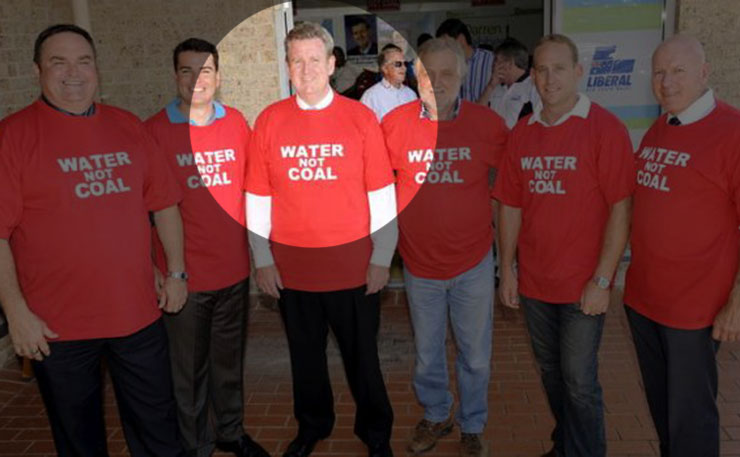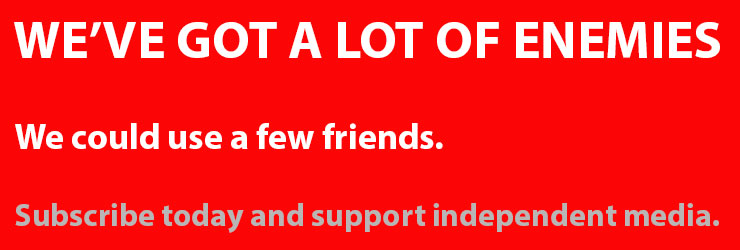The more things change, like heads of government, the more they stay the same. Rod Campbell explains.
Today, the New South Wales Planning and Assessment Commission will conduct a hearing about the hugely controversial Wallarah 2 coal mine near Wyong. Ringing any bells? It should.
Remember Barry O’Farrell? The NSW premier who resigned after a scandal linked to a bottle of wine?
Barry’s gone now, but Wallarah was tied up in a lot of his problems, and has proven much harder to get rid of.
The Wallarah 2 coal project is near Wyong on the Central Coast of NSW. It’s been around as a proposal since the mid 1990s. For a while BHP Billiton owned part of it but sold because, according to locals, they realised it was technically and politically risky to mine around the drinking water catchments and aquifers of the Central Coast.
That was also the reason O’Farrell, as opposition leader, promised to stop the mine, famously wearing a “Water not Coal” t-shirt on a trip to the area.
O’Farrell broke that promise once he came to office as premier. Why? We will probably never know for sure, but it has been suggested that lobbying was involved. Nick Di Girolamo, the lobbyist who sent the premier the infamous bottle of wine, also worked for Wallarah 2’s owners, Kores which is owned by the Korean government.
Anyway, Barry’s gone, Nick’s gone, the wine has probably been drunk, but Kores and the mine proposal are still here.
And why would you go away when the NSW government is prepared to throw hundreds of millions of dollars at the owners of controversial coal proposals, if you just hang around for long enough? They’ve just paid BHP $220 million to not mine in the Liverpool Plains further west.
With the coal boom well and truly over, it is unlikely that Kores would actually spend the $1.5 billion dollars needed to build the Wallarah 2 mine. It’s relatively small, and deep underground in environmentally and politically sensitive country. You can buy an existing coal mine for a fraction of that amount at the moment, with mines changing hands for between $1 and a couple of hundred million, so the Wallarah mine probably isn’t financially viable.
However, the words “unviable” and “mine” are just not words that the NSW Planning Department ever puts together. They have put on display an economic assessment commissioned by Kores which claims the project has net benefits of $774 million, at least $274 million of which would accrue to the NSW community (page 44-46).
A few things in this economic assessment should have been picked up by Planning.
First, the assessment claims that Wallarah would be one of the cheapest mines to operate in Australia, if not the world. There is hardly a mine in Australia that can operate for USD$40 per tonne. (See figure 3) But that’s how much Wallarah’s economists are claiming, even though it is small, deep and in a sensitive area.
To see this for yourself, take annual average operating of AUD$192 million (p32), divide by average annual production of 3.974 mtpa (p33) and you get AUD$48 per tonne. Add AUD$7 per tonne royalty for a total of AUD$55. Convert to USD and depending on the day, you’ll get USD$40-41.
Second, the coal price used is AUD$100 per tonne, substantially above the current AUD price of $88 per tonne, and far above the long term Treasury forecast of around $80 per tonne (Chart 20).
Thirdly, Planning should have noticed that this assessment was written by Gillespie Economics. These consultants estimated the net benefits of earlier iterations of the Wallarah Project at up to $1.5 billion. The Planning Assessment Commission (PAC) described their last economic assessment as “not credible”.
In fact, it was Gillespie Economics’ last assessment of the Wallarah project, and the PAC’s scathing treatment of it, that prompted an entire rewrite of economic assessment guidelines for mining projects in NSW. Considering the standards of economic assessment produced by most fossil fuel companies in Australia, this was quite an achievement.
So to conclude, a hugely controversial mine, linked to the downfall of a premier and opposed by locals, is allowed to resubmit an amended planning application after it was beaten in court by the local Indigenous people. It is reassessed by economists who were found to be “not credible” by the PAC last time, but have once again miraculously found hundreds of millions in benefits.
O’Farrell wasn’t able to keep his promises to the Central Coast. It takes communities made of sterner stuff to take on such a flawed system and the people behind it.
Fortunately, there’s some pretty tough types living on the Central Coast and they’re not going anywhere.
Donate To New Matilda
New Matilda is a small, independent media outlet. We survive through reader contributions, and never losing a lawsuit. If you got something from this article, giving something back helps us to continue speaking truth to power. Every little bit counts.





